





One of the best landscape palms are the Livistonas. These are tall (mostly), solitary fan palms from Australia, Asia (and one from Africa). Most are cold hardy, though not all, and relatively fast growing (again, not all), which makes them useful and practical landscape palms in both the tropics and more marginal zones. The following article is an introduction to some of these palms and my experiences growing those that I can in southern California.
When I first became interested in palms, Livistonas were not one of the palms that immediately attracted me, probably because some looked far too similar to our common and weed-like Washingtonia robustas (Mexican Fan Palms) which crowd the landscapes here in southern California. But several things changed my mind. First of all, I eventually appreciated the differences between Livistonas and other palms- they really have many dissimilarities to Washingtonias. Secondly, there are variety of Livistonas and though the general idea is the same, some are quite unlike the others. And lastly (probably most importantly) after some very cold winters, many Livistonas were some of the few untouched palms by the crummy weather extremes we have here in southern California.
Though most Livistonas are pretty cold hardy, a few notable ones are not. One of the most popular Livistonas in the tropics, Livistona rotundifolia, cannot survive here in California except in perhaps the most perfect and warmest of the microclimates, and then is still a slug of a palm. Some others, notably the ones with skinny trunks or blue leaves are also on the marginal side. But the rest are some of the hardiest and easiest palms one can grow in a marginal climate (all seem to grow great in tropical climates). Some are even decent indoor plants, though most are not.
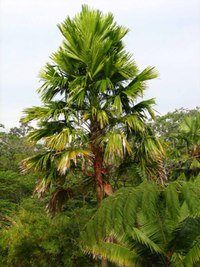
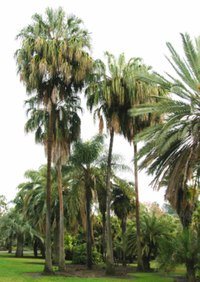
Livistona rotundifolia in Hawaii... nice palm but very tropical; the more 'typical' ribbon fan palm look of these Livistonas in southern California
All Livistonas are single trunked fan palms with unsplit leaf bases. This unsplit characteristic is one of the best ways to tell this genus apart from Washingtonias, which have split leaf bases. The leaf bases, in many species, are retained along the trunk, especially near ground level. The petioles of Livistonas are invariably armed, some with outrageously huge and curved teeth/thorns that are extremely sharp. The leaf tips of many species are droopy, which along with their finely split leaves, makes them look somewhat delicate and definitely ornamental. The leaves are costapalmate (palmate with a midrib) but some are classicly folded at the midrib while others have regular flat palmate-looking leaves. Most are monoecious species, but some seem to be dioecious.
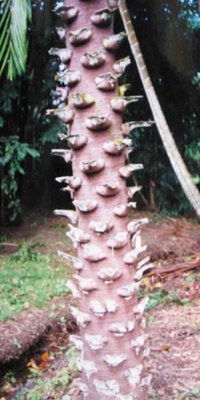
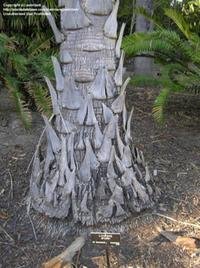
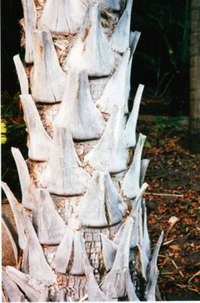
Livistonas benthamii, drudei and australis showing retained and unsplit leaf bases on trunk
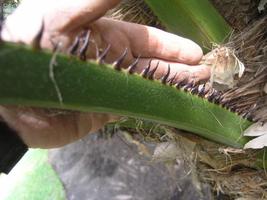
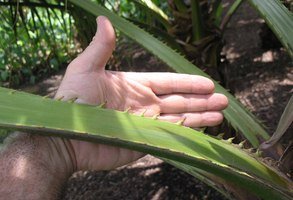
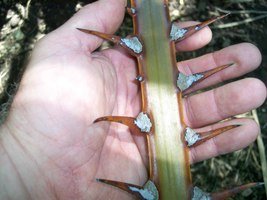
Petioles of various Livistonas showing variation in teeth: Livistona australis, chinensis and saribus
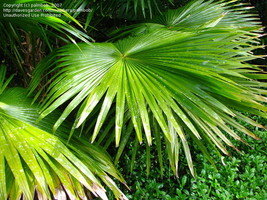
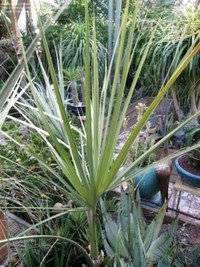
the nearly flat, palmate leaves of Livistona rotundifolia, and the finely split markedly costapalmate leaf of a young Livistona alfredii
The following is a discussion of some of the more commonly grown species starting with the most common to some of the least common species in cultivation.
Livistona chinensis (Chinese Fan palm)- this is THE classic Livistona and the hardiest of all the Livistonas. Though this species is native to Taiwan, most plants are found on some Japanese Islands. The leaves of t his palm are fairly large and marked costapalmate (palmate but with a ‘costa' or midrib down the middle at which point the palm has a deep ‘V') with elegant drooping leaflets about the distal ¼ of the leaf. Though it can grow to 40' tall, most specimens take a very long time to get there, and if grown in a hot dry climate in full sun, will probably never get there. It tolerates hot full sun, but seems to prefer some shade and even tolerates full shade surprisingly well. This is one of the reasons this species makes a good house or potted plant in low light situations. Still, as is the case for most all the Livistonas, this one has very sharp teeth along the petioles which may make it a less than desirable plant for narrow walkways or halls. As mentioned above, this is a cold hardy palm and tolerates temps easily down into the mid teens. It is quite versatile, doing well in the tropics, the deserts and all warm temperate climates. And thankfully it is also very common and inexpensive.
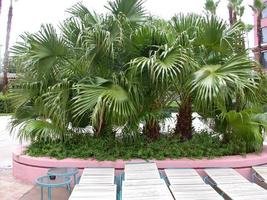
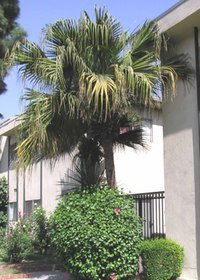
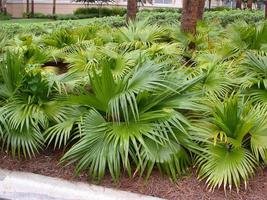
Livistona chinensis in Florida landscaping, as a solitary planting in southern California, and almost as a groundcover in Florida
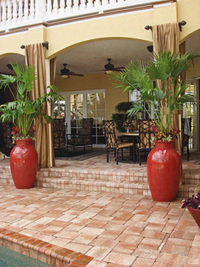
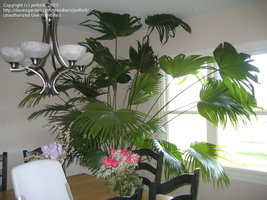
Several examples of Livistona chinensis used as a potted plant (photos by KatG and jenfur8)
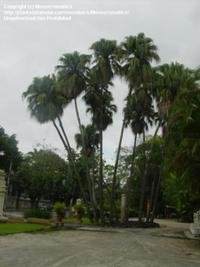
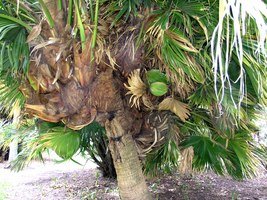
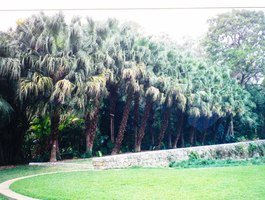
Very tall, old palms in Brazil (photo by Monochromatico), and a multiple headed freak row of palms in Florida
Livistona rotundifolia (aka Footstool Palm or Roundleaf Palm), though basically impossible to grow in a Mediterranean climate like southern California, is one of the most commonly grown palms throughout the tropics. This is due primarily to its amazing rapid growth rate (one of the fastest growing of all palms)- in ideal equatorial cultivation one can grow this palm from seed to a 10' tall trunking palm in just 4-5 years. Few palms can claim that rapid growth rate. And additionally it moves easily making it a very useful landscape palm. And, as a young palm, it can be slowed down and kept in a pot for several years, tolerating low light situations as a house palm in the tropics. Young palms develop huge leaves up to 6' wide and nearly completely palmate. As it matures, the leaves become much smaller. The trunk is bare and a deep red-brown, and very ornamental. This species originates from Malaysia to the Philippines and can obtain heights of 80' or more. Some rate this a zone 10b palm with some able to grow it in 10a... one should amend this cultivational description to include ONLY warm, humid 10a and 10b zones, as the equivalent zones in California still cannot support the growth of this species except in very exceptional protected microclimates... and even then it struggles massively and grows exceptionally slowly. Livistona robinsoniana is probably the same species, but some list it as a separate one.
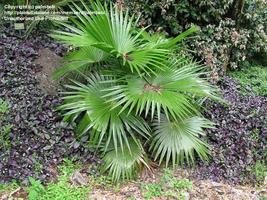
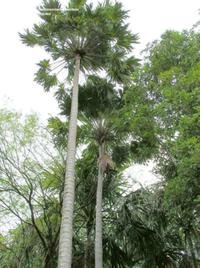
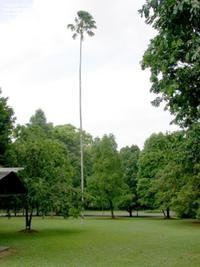
seedling Livistona rotundifolia in Hawaii mature palms in Hawaii very old, tall plant in Singapore
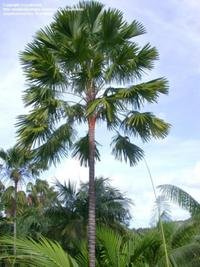
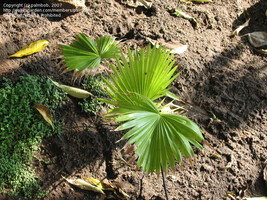
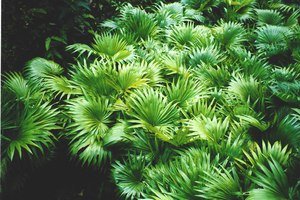
Nicely grown mature palm in tropics, and a struggling (but surviving!) seedling in southern California; seedlings growing in Thailand
Livistona decorum (aka decipiens, or the Ribbon Fan Palm) is probably the second most commonly grown species in the temperate regions and is one of the hardiest of the Australian species. The name was recently changed to decorum from decipiens thanks to some historical bragging rights nomenclature claim, but most plants in cultivation will still be called Livistona decipiens. This plant is not immediately distinct from Livistona chinensis until one notices the leaf size to palm ratio (this one has much smaller leaves) and the growth rate (this one is much much faster). The leaves are similar in appearance, other than the size, having finely split leaflets and elegantly drooping leaf tips. Of all the Livistona species, this one probably has the most finely split leaves making the drooping leaf tips very thin and wispy. The color of the leaves is a bit darker and duller green. Young palms often have a lot of maroon in the leaves and petioles, though this characteristic is not as exaggerated as in Livistona mariae (see below). It is a moderately tall palm growing up or over 50'. The teeth of Livistona decorum are relatively small for a Livistona, but arguably some of the sharpest teeth in all the palm family. Pruning this palm with bare hands is certainly not recommended.
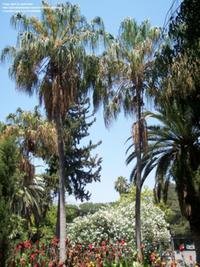
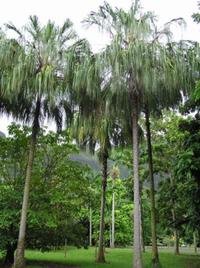
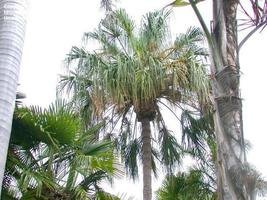
pair of Livistona decorums in California; pair in Hawaii (this is one of the few palms that looks just as good in temperate climate); close up of crown
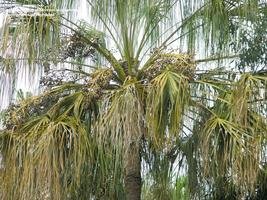
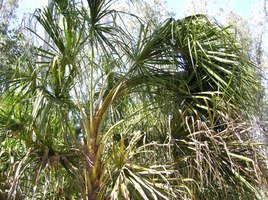
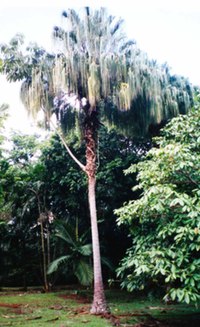
even closer view of crown showing finely split leaves; leaning palm (this is one of the few palm species that suffers from this malady now and then); nice looking palm in Hawaii with Schefflera species growing out of trunk (rooted in retained leaf bases)
Livistona australis (also from Australia as the name suggests) is another commonly grown Livistona, but perhaps not so common one will likely find it at a garden outlet center as one could the two first ones discussed. This palm has several synonyms including Livistona Eungella Range and Livistona Paluma Range, but these are just subtle geographic related variations upon the same species. Telling this species from Livistona decorum is a real challenge, and frankly I am usually not up to it. Seedlings are bit easier to tell apart as they have greener leaves and the leaf tips don't droop until later in life (this is assuming one has one of each growing side by side to see these subtle distinctions). The mature height potential of this species is quite a bit more than Livistona decorum growing up to nearly 100', though I have never seen any get that tall. Cultivationally it is nearly identical to Livistona decorum, both with hardiness down to around 20F.
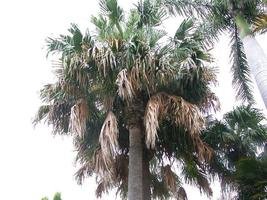
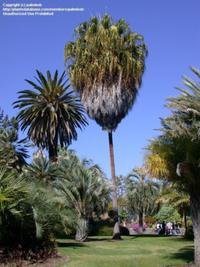
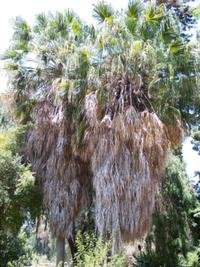
Livistona australis examples (all in southern California)
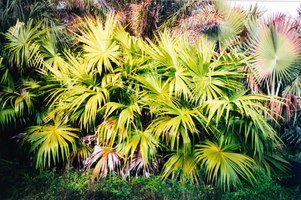
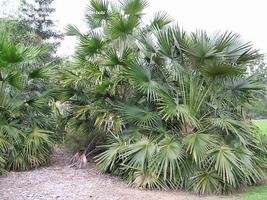
Livistona australis covered with snow (photo by kennedyh) Young palms in botanical garden
Livistona saribus (aka Taraw Palm) is a species from all over Asia- from China, Thailand and most of the surrounding countries, down to Borneo and even to the Philippines. Though tropical in origin, it has amazing tolerance for cold, handling temps down into the mid 20s easily- I would safely categorize this as a 9b palm and have never seen cold damage on this one in most areas of southern California. This is a beautiful species with large, nearly circular bright green to yellow-green leaves that are nearly completely palmate (only a hint of costapalmate in some leaves). Other than the amazingly beautiful leaves, its most outstanding feature are its massive and curved deep black, sharp thorns along the petioles. Only Livistonas benthamii and jenkinsiana come close to having marginal petiolar teeth this big and interesting. Though considered a fast growing species in warm, humid climates like Florida, where it can grow very tall (though not usually the 90' potential it reaches in the true tropics), it is one of the slower Livistonas in California taking decades to form even a trunk sometimes. I have grown many of these from seed and most are nearly 10 years old now, and not even close to making a trunk. Few specimens in California are taller than 30' even though it's been grown here for over 50 years.

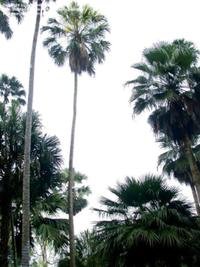
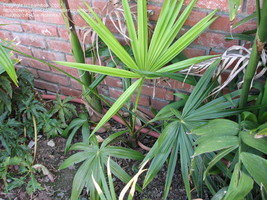
young Livistona saribus clump in Florida mature palm in Singapore Seedling in my yard
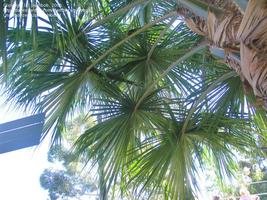
 mature leaves and young leaves
mature leaves and young leaves
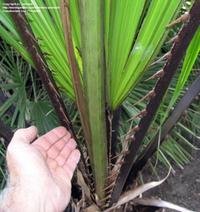
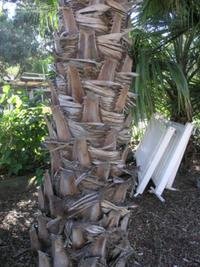
shot of dark, nearly black petioles and huge teeth; ornamental weave on trunk
Another Australias similar in appearance to the above two Livistonas from Australia, but maybe even a bit more beefy, is Livistona nitida. This species is rapidly becoming a commonly grown palm, though as yet, most are still unfamiliar with it. As a seedling this is a remarkably fast growing palm and arguably one of the fastest growing off all the Livistonas, particularly in a dry, Mediterranean climate. The colors of a young seedling include bright yellow green and red-brown, making it look a LOT like a Washingtonia save for the unsplit leaf bases. Its leaves only begin to droop as it matures (like a Washingtonia, too), but as it gets even older, it starts looking more and more like Livistona australis. Hardiness is probably similar to the above two species (near 20F).
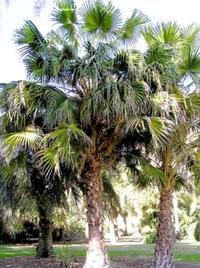
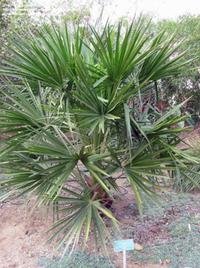
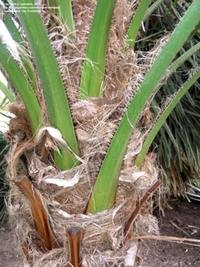
Livistona nitida maturing adult seedling close up of trunk and petioles
Another very similar Australian palm to the above 3 Australian Livistonas is Livistona drudei, a relatively uncommonly grown palm though I suspect that is partly due to is somewhat lack of unique landscape characteristics. This palm is somewhat less hardy, also, than the above three barely tolerating severe frosts down into the mid 20s. It is a moderately tall species growing up to 80' and having somewhat longer, more elegantly drooping petioles than some of the above palms. But the leaflets droop very similarly and all else is similar as well.
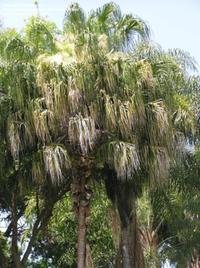
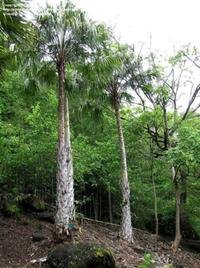
Livistona drudei crown (looking a LOT like Livistona australis to me); palms in Hawaii
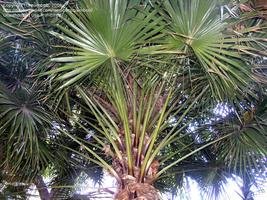
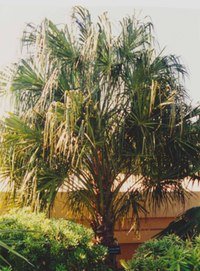
shot up into crown excellently grown palm in So California
Livistona mariae is another beautiful, but similar Australian palm. Currently it is considered a separate species from Livistona rigida and Livistona occidentalis, but I cannot easily see the differences. Some say Livistona rigida has more rigid leaves that do not droop at the tips, but if that is the case, I have yet to see an adult of this species. I have never seen a Livistona occidentalis, so will just leave that one out of the discussion for now. This species is popular with palm growers when it is young as it is remarkably colorful in full sun situations- a deep maroon color. Sadly, this amazing coloration fades rapidly before trunking life begins, first to a dull grey -green with reddish margins, and then just a dullish green in maturity. Mature specimens, at least here in California, are always a bit on the unkempt side, not matching the super-finely split leaf elegance of Livistona decorum or australis. It too grows tall (up to 80') and is a moderate grower (slower than the above species, but not slow).
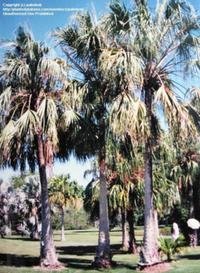
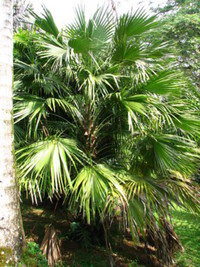
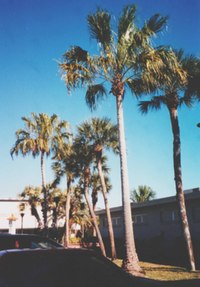
Livistona mariaes in Thailand in Hawaii in Florida on right with Livistona decipiens behing it on left
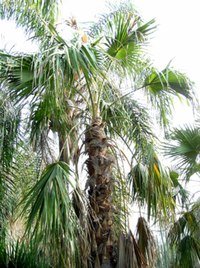
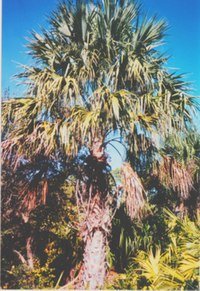 Southern California and Florida Livistona rigidas
Southern California and Florida Livistona rigidas
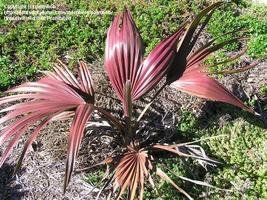
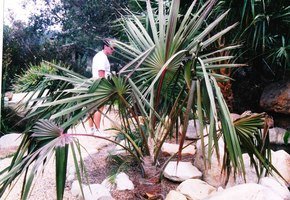
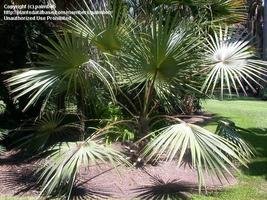
very young palm showing typical red of seedling older seedling losing the red color Livistona rigida seedling turning grey-green from red
Livistona fulva (also referred to for many years as Livistona Blackdown Tableland- which is where it's from in Queenland), though not common in cultivation, is becoming more so lately. It is another Australian palm, but does not resemble too many, if any, of the other Livistonas in terms of leaf shape and color. This palm has non-drooping leaflets and an ornamental rust color on the undersides of the newest leaves in a maturing palm. As a young palm, the crowns are fairly open with wide leaflets and markedly costapalmate leaves. Though it does make a lot of new leaves per year (more than most Livistonas), it seems to slow in terms of gaining overall height and the leaf crowns become remarkable dense. Its ultimate height is only about 40'.
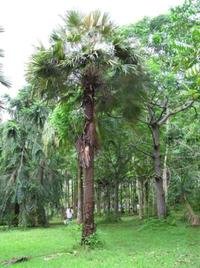
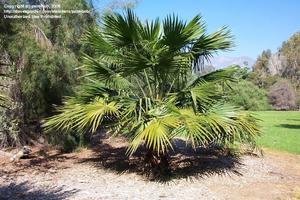
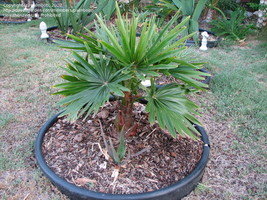
Mature Livistona fulva in Hawaii Younger palm in Los Angeles my young seedling
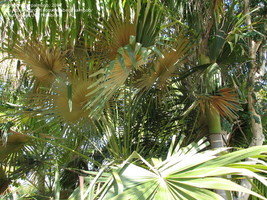
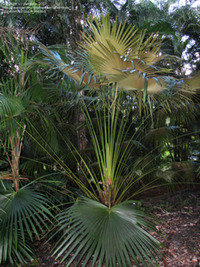 showing rust color under leaves in Calif. and Hawaii
showing rust color under leaves in Calif. and Hawaii
Livistona lanuginosa (aka Livistona Cape River, or Wooly Livistona) is another droopy-leaved Australian palm but it looks somewhat different in that is has grayish leaves with some green in them thanks to a layer of ‘wool' on the leaves upper surfaces. The leaves themselves are also narrower than most other large Livistona species. It also has a different silhouette in that most of the leaves are more upright with only a few, if any, in horizontal attitude. It is a modestly hardy species tolerating temperatures into the high 20s easily, but struggling with severe frosts below that.
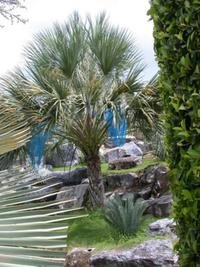
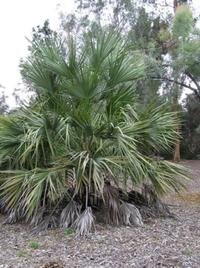 Livistona lanuginosas in Thailand and California
Livistona lanuginosas in Thailand and California
Livistona muelleri, though not commonly grown in California, is a popular species in warmer, more tropical climates. This is because it is an amazingly ornamental plant, with smallish, flat (palmate), stiff leaves (no drooping leaflets in this species). Except for the lack of fiber on the trunks, younger palms could be confused with a smaller-leaf version of a non-suckering Chamaerops palm- similar leaf shapes and equally sharp, dangerous petiolar teeth. Its common name is the Dwarf Fan Palm, though in New Guinea and northern Queensland, some trees grow up to 60'. But it is certainly a slow grower, which is another reason it is popular in the tropics- takes many decades to outgrow its location in smaller gardens. Here in California this palm is nearly impossible to grow, often succumbing to a variety of bud diseases- it just does not like our cool, dry climate.
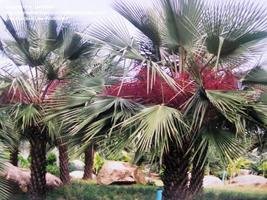
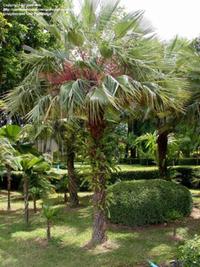
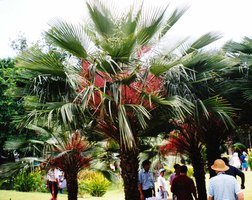
Livistona muelleris in Thailand showing amazing brilliant red flowers- one of the most spectacularly colored flowers of all palms
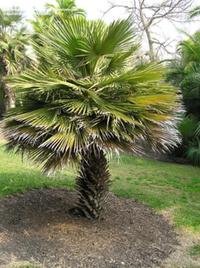
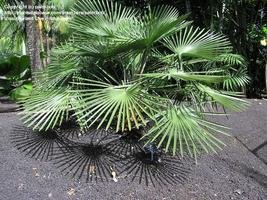
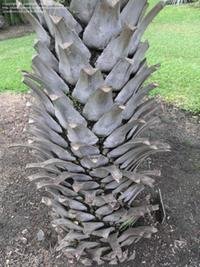
Typical (actually better than typical) look of palm in California seedling in Hawaii trunk detail in California
Livistona jenkinsiana (aka Livistona speciosa) is another tropical species from India and Thailand into China. It is a massive palm up to 80' tall but with huge, flat completely circular leaves (young palms have leaves that sometimes overlap more than 360 degrees) that are only somewhat split (making them look like large, fan-like plates). The thorns are quite large and sometimes this palm can be confused with Livistona saribus (though not here in California where this species is exceptionally slow growing and marginal).
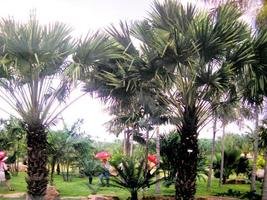
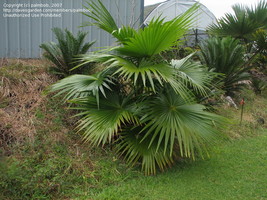
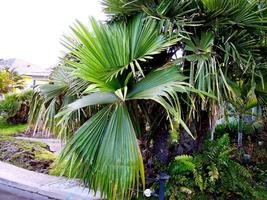
Maturing Livistona jenkinsiana palms in Thailand young palm in Hawaii Exceptionally healthy looking palm in California
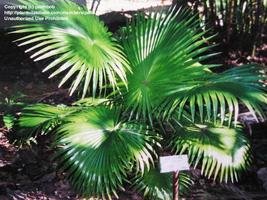 nearly circular, only slightly divided 'pie-plate' leaves of seedling in Florida
nearly circular, only slightly divided 'pie-plate' leaves of seedling in Florida
Livistona merrillii, though once a very rare species, is slowly becoming more popular as many discover its amazing cold hardiness considering its tropical Philippine islands origin. I have yet to see a mature palm, but many southern California gardens have seedlings. These palms are very ornamental as young palms having open crowns with exceptionally long peitoles ending in nearly circular, flat leaves of bright green leaflets with only a hint of droop near their tips. I have no idea how tall this species will get here in California, but in the Philippines it grows up to about 50'. I doubt it will match that here.
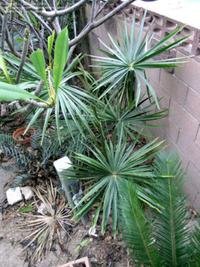
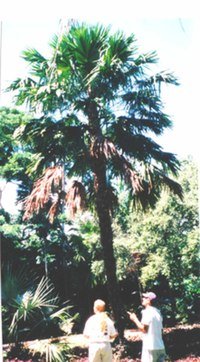
rare seedling of Livistona merrillii in southern California; mature palm in Miami
Livistona benthamii is another one of the droopy-leafed Australian species, though it also is from New Guinea. This palm tends not to look too much like the other species in that it retains far more leaves along the trunk (often half the length of the trunk), and even after they die, the leaf bases hang on forever, giving the trunk the look of having steps upon which one could climb to the top. However, this species is one of those with deadly sharp, huge petiolar teeth, making climbing difficult I'm sure. The leaves are somewhat wispy in comparison to the other larger Australian, droopy-leaved palms. Here in California this is a tough grow, though I have seen some mature palms. I have tried many times to grow this species without success. Yet in the tropics it's a pretty easy plant and even fast growing (it is super slow here in a dry, cool climate!).
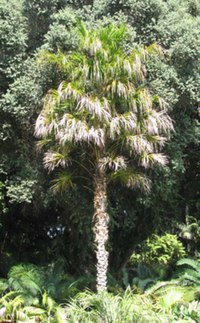

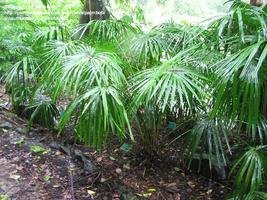
Rare mature Livistona benthamii in southern California; same species in Hawaii; young palm in Hawaii
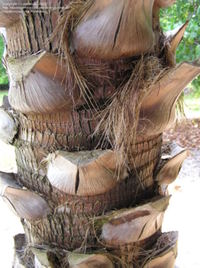
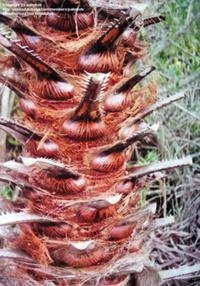 shots of retained leaf bases
shots of retained leaf bases
Livistona carinensis is the only African Livistona (Somalia and eastern Arabia) and is one of the trickiest to grow in all but the warmest and/tropical of climates. It is an ornamental species with jet black and deep yellow-orange petioles. The leaves are fairly flat with just a hint of costapalmate folding in the centers and do not have the classic Livistona drooping of the leaflets that make so many other Livistonas such elegant landscape and potted palms. It is a very slow growing species relatively and here in California they pretty much take a lifetime to grow from small seedling to adult size.
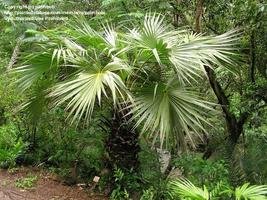
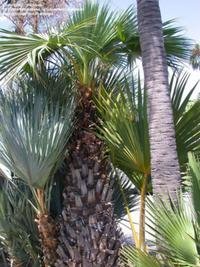
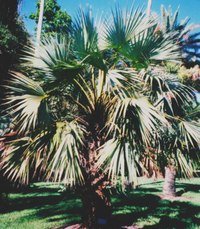
examples of Livistona carinensis growing in Hawaii, southern California and Miami, Florida
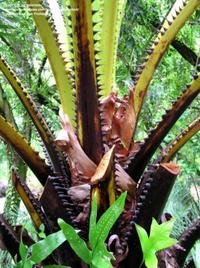
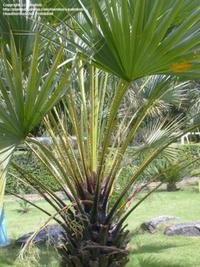
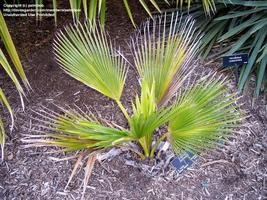
shot of black to yellow petioles slightly farther shot of petioles seedling struggling in southern California
Livistona victoriae (aka Livistona Victoria River) is a very different looking species, at least from most of the other Livistonas. This plant has blue-grey to slate grey leaves and seems to prefer a dry, hot climate, at least to a cool Mediterranean one. It still would prefer the tropics most of all however, and was growing happily and beautifully in Thailand where the rainfall is impressive. Here in California this palm is exceptionally slow- probably the slowest of all the Livistonas one can grow here to maturity. My palm is 10 years old and still only 18" tall, though it is at least making full fan leaves now. This is a marginal palm, though, and suffers severely if temps begin to drop much into the 20s. It somewhat resembles a Brahea armata in color and shape, but 10x slower growing.
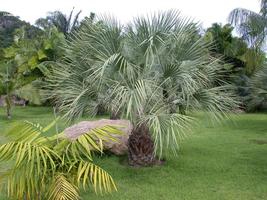
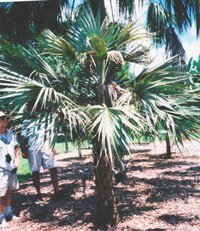
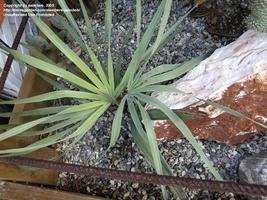
Livistona victoriaes in Thailand, Miama, Florida and seedling in California
Livistona alfredii is the other grey-green-leaved species and is a far better choice for southern California. It not only grows much faster than Livistona victoriae, it has better cold tolerance as well (no damage down to 26F in my yard). Still, it is not a fast growing palm and is extremely rare in cultivation though I am unclear why. I certainly should be grown a lot more here in California and I feel quite lucky to have one at all.
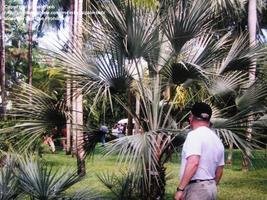
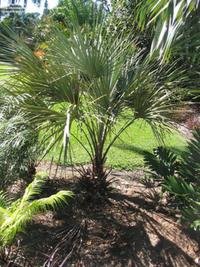
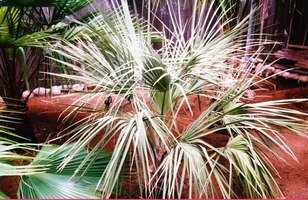
Livistona alfredii in Thailand Young palm in Florida seedling in southern California
Livistona humilis is a true dwarf species from Australia and not a typical Livistona by any means. Not only is it small (maximum height 20') but has completely flat, stiff leaves that do not look like any other Livistona species. It is also a dioecious species which is unusual for a Livistona. This is an extremely marginal palm here in southern California and I know of no one who is having any luck with it (at least one botanical gardens claims they have it, but I think they are mistaken). This palm does far better in constantly warm climates, either dry or humid.
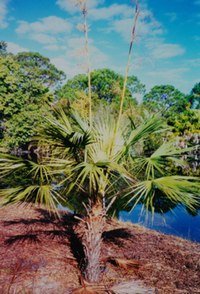
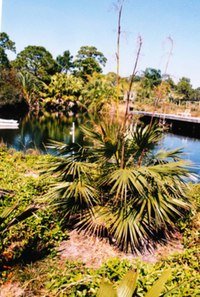
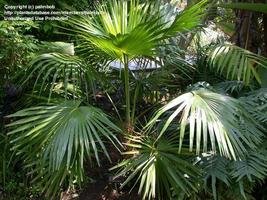
two shots of Livistona humilis flowering in Florida; palm in southern California botanical garden labeled as L humilis... is it?
Livistona inermis is a fantastically ornamental dwarf Australian species with amazing petiolar color (pink-orange!) and very sparse looking wispy leaves segmented completely down to the petioles. Seedlings are far better looking than adult palms and are elegantly delicate in appearance. Sadly, as this plant matures, most leaves are lost and they develop into tall, spindly plants (trunks rarely over 4" in diameter) with hardly enough foliage to even look alive. Though they grow up to 30' tall, most individuals don't seem to make it near that height. In Australia is survives in one of the most hostile climates imaginable- the dry, hot outback in areas with very unpredictable rainfall. Yet it is one of the most fastidious of the Livistonas demanding constant warmth. This palm can be grown in California, but only in the rare nearly frost-free parts of the inland deserts where temps often climb above 110F. I have tried over and over to keep this palm alive with no success. Thankfully hardly anyone else has either here in California, so I don't feel so bad.
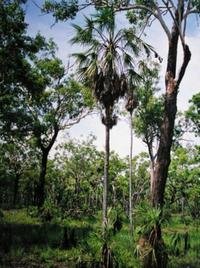
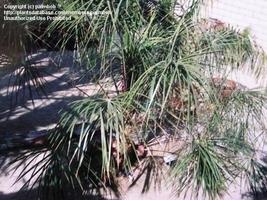
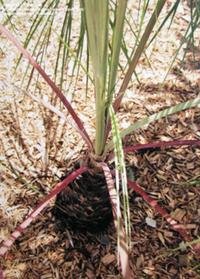
Livistona inermis in Australia (photo by Sam Sweet); seedling in Palm Desert, California; seedling in central Florida
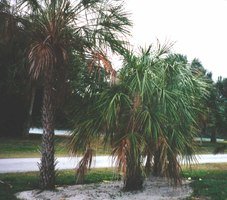
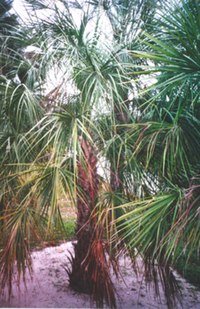
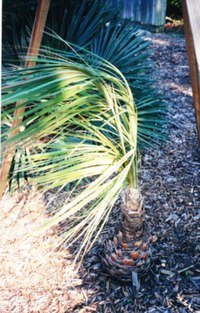
3 less than quality shots of Livistona inermis (mature palms) in Florida, and a another seedling in Florida
There are other species not discussed here, but they are quite rare and I have no personal knowledge of any of them. But I think there are enough here to keep the palm growers and landscapers busy.
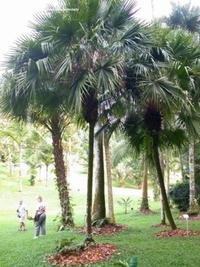
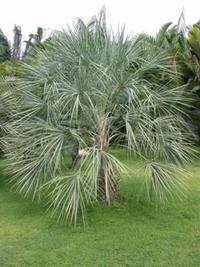
Livistona endauensis in Singapore Livistona loryphylla in Thailand
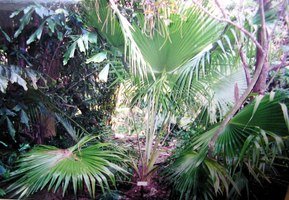
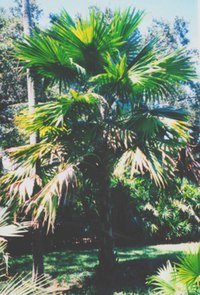
Livistona woodfordiana in Floirda Livistona robinsoniana in Florida (probably Livistona rotundifolia variety)
Copyright © www.100flowers.win Botanic Garden All Rights Reserved